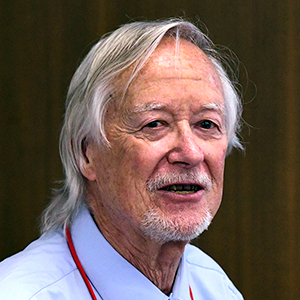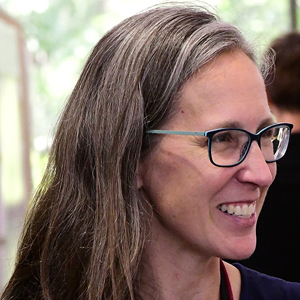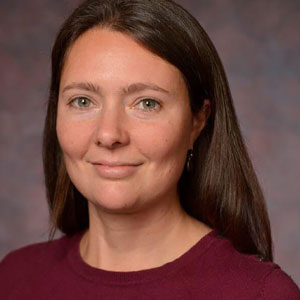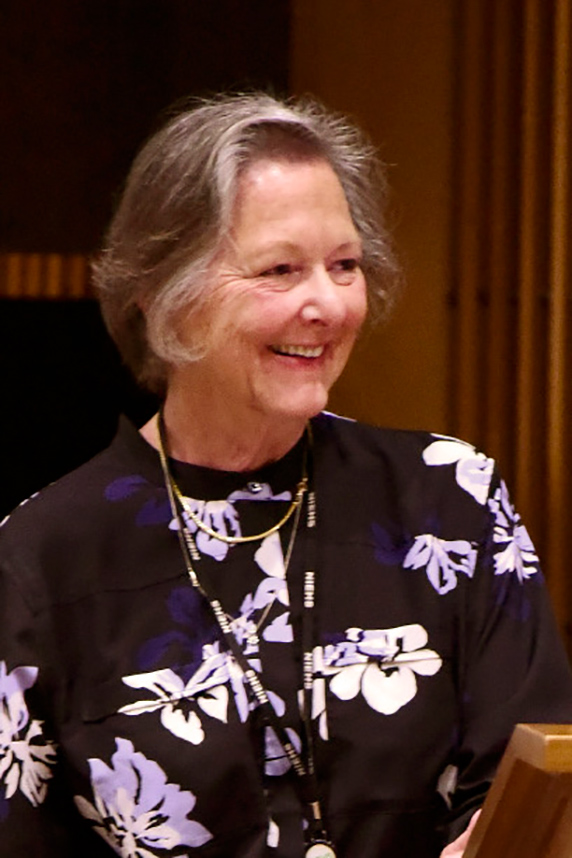 “We are incredibly lucky to have six new awardees this year,” said Shreffler, shown at the 2018 ONES symposium. (Photo courtesy of Steve McCaw)
“We are incredibly lucky to have six new awardees this year,” said Shreffler, shown at the 2018 ONES symposium. (Photo courtesy of Steve McCaw)Recipients of the NIEHS Outstanding New Environmental Scientist (ONES) grant gathered virtually July 27-28 for a lively symposium.
“We are delighted that it went so well in the remote format,” said ONES Program Coordinator Carol Shreffler, Ph.D. “Interaction is the key to the success of these meetings. The awardees took full advantage of opportunities to ask questions and engage with each other.” More than 80 people registered to attend.
Participants shared research, discussed careers, and carried on a wide-ranging discussion with NIEHS and National Toxicology Program Director Rick Woychik, Ph.D. “We hope this program will … support the kind of innovative research that will help launch careers of the next generation of environmental health sciences,” Woychik said.
Career game-changer
Keynote speaker Patricia Opresko, Ph.D., from the University of Pittsburgh, said ONES was a game changer for her career. “I was nominated for the ONES award when I was only four months into running my new lab,” she said. Thankfully, she had followed a mentor’s advice and had already prepared a grant application.
Opresko and her lab study mechanisms behind the shortening of telomeres, which are caps on the ends of chromosomes. Opresko is interested in how exposures to genotoxins and oxidative stress speed up the process. In normal growth and aging, she explained, telomeres shorten each time a cell divides. Yet cancer cells evade that outcome, maintaining robust telomeres despite uncontrolled growth.
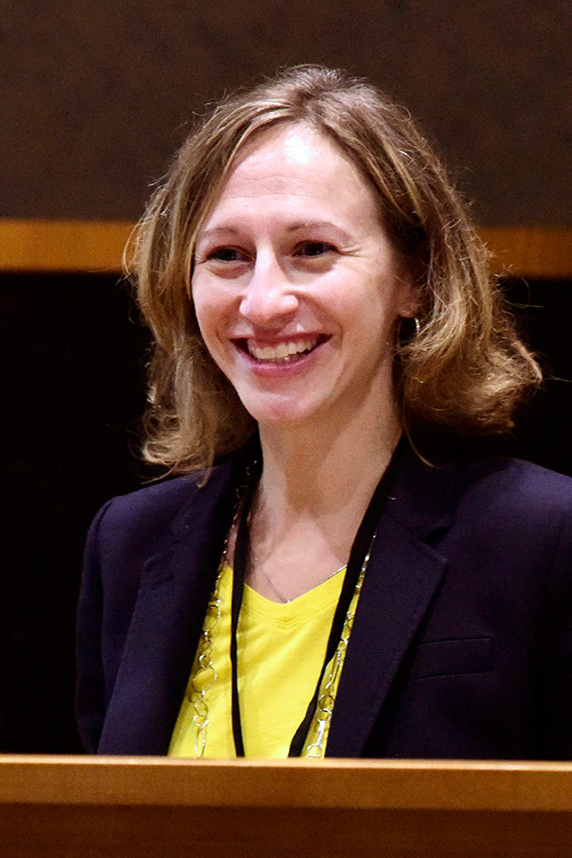 Opresko, shown at the 2017 NIEHS conference on telomeres, said collaborations were the key to making it through a mid-career hump. (Photo courtesy of Steve McCaw)
Opresko, shown at the 2017 NIEHS conference on telomeres, said collaborations were the key to making it through a mid-career hump. (Photo courtesy of Steve McCaw)Getting established in the field
With ONES funding, Opresko visited the lab of Peter Lansdorp M.D., Ph.D., to learn a powerful technique for staining telomere ends. “I appreciate that I could stand side-by-side with his staff and learn how to do this,” she said.
Opresko said her 2018 promotion to full professor came thanks to the ONES award and the career enhancements it supported, including:
- Taking a course in quantitative fluorescence microscopy.
- Buying a microscope that remains the main workhorse of her lab today.
- Participating in Environmental Mutagenesis and Genomics Society conferences.
- One-on-one conversations with NIEHS scientists about their research.
“It is incredibly important to attend scientific conferences, pitch your science, and get feedback from folks who will be your reviewers [on scientific publications],” she said. “The ONES award gave me the opportunity to establish myself in the telomere field.”
Opresko was among the first ONES awardees in 2006, and she repeated that pioneering role in 2019 as part of the first group to receive River grants.
Listening session spotlights diversity supplements
Woychik met with participants in an extended free-form discussion. “These are a very valuable way of keeping lines of communication open,” he said of the sessions with staff, grantees, center directors, and others.
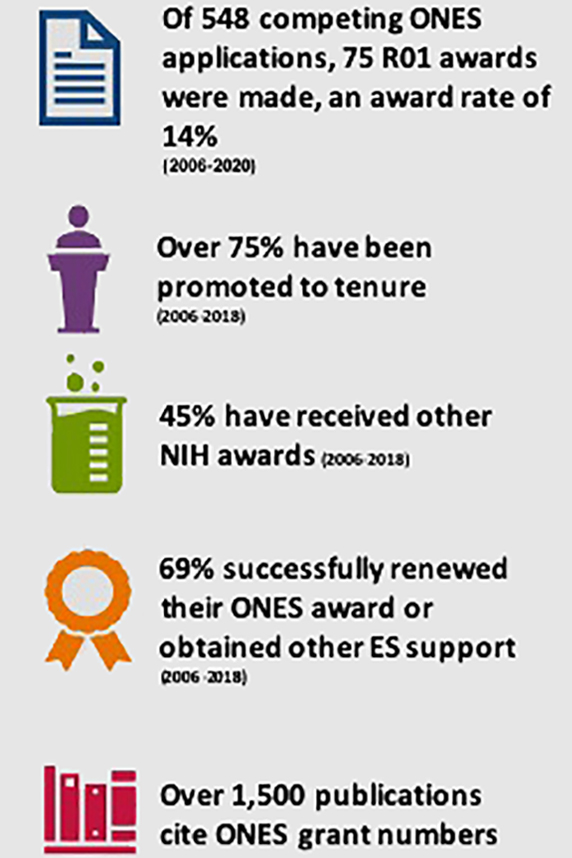 Achievements by ONES awardees from 2006 to the present include those shown above as well as seven patents. R01 — individual research grant; ES — grant administered by NIEHS. (Image courtesy of NIEHS)
Achievements by ONES awardees from 2006 to the present include those shown above as well as seven patents. R01 — individual research grant; ES — grant administered by NIEHS. (Image courtesy of NIEHS) Much of the discussion centered on challenges to obtaining National Institutes of Health (NIH) diversity supplements, designed to help diversify the research workforce. Symposium participants described constraints that stop them from applying, especially the policy that candidates must not already be funded by the grant.
- There can be delays between submission of the application and funding, which can shrink the pool of qualified applicants.
- A researcher whose university requires that they identify a funding mechanism when offering a postdoctoral fellowship cannot use this supplement.
- The point in the grant cycle at which one may apply and other eligibility constraints reduce its usefulness.
“What would you change if you could?” Woychik asked. He will share the feedback with NIH, which governs diversity supplement polices. “This might be perfect timing,” he said, referring to NIEHS and NIH-wide efforts to combat effects of systemic racism. “It gives us something very specific to work on.”
Awardees raised other topics such as interactions with other parts of NIH. Woychik described a growing wave of interest in collaborations that cross traditional boundaries between research fields.
Another comment addressed rural and low-income health disparities, which tend to occur in areas without a robust research infrastructure. Acting Deputy Director Gwen Collman, Ph.D., pointed to the NIEHS Partnerships for Environmental Public Health. “There is lots of interest there in rural health,” she said.





